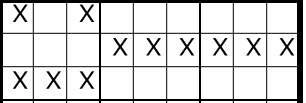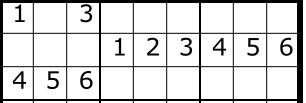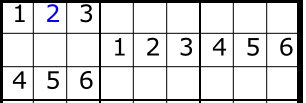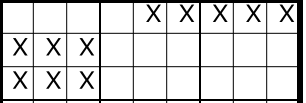Look for Patterns
A technique for solving Sudokus is to look for helpfull patterns of occupied and non-occupied cells.
It is easiest to understand with an accompanying example:
-

- An excerpt of a Sudoku.
You can see which cells are occupied, but not which number is given, since it's irrelevant for using and understanding the described technique.
In the middle row there are three numbers missing. You can't decide which number goes where, but you know that these three cells have to be occupied by the three missing number.
Then you know which number goes into the last unoccupied cell in the left block.
And now an example with numbers:
-

- The same excerpt as before, this time with numbers given.
In the middle row the numbers 7, 8, 9 are missing.
In the last unoccupied cell there has to be a 2.
-

-
The same excerpt as above, this time with an inserted
2
You could have found that 2 with crosshatching, but looking for
patterns plays well to the way our brain works, and therefore it is
very efficient to use manually.
You should view this technique as a tool to find a good place to apply other techniques to.
The patterns you can search for are many fold, for example you can rotate a given pattern by 90 degrees and get another pattern you can look for.
In the same way you can exchange rows with blocks, the resulting pattern is the following:
-

- You can look for this pattern as well